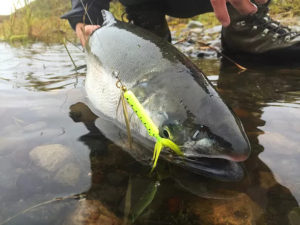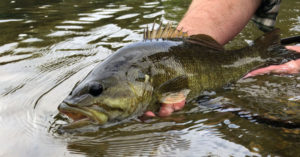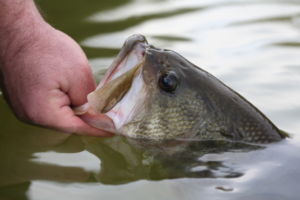October Bass at High Falls
with Wayne Glaze
Georgia has an abundance of smaller public lakes that bass fishermen often overlook. Many of them have excellent populations of keeper bass, and some harbor good numbers of big bass. High Falls Lake is one of them that has both.
Located just off I-75 north of Forsyth, High Falls is a 660 acre Georgia Power Lake and Georgia State Park. It is a very old lake, ringed by cabins and docks. Boat motors are limited to 10 horsepower, eliminating skiers and jet skis. All boats must be off the lake at night, so you can not launch until just before sunrise. And you must come in at sunset.
The lake is on the Towaliga River and has three main creeks entering it. Buck and Brushy Creek enter close together on the west side about half way up the lake and Watkins Bottom enters from the east across from them. Two ramps serve the lake, both State Park ramps so you will need a parking permit. One is right at the dam and the other is just off High Falls Road where it crosses Buck Creek.
High Falls is a fertile lake and the water is usually tinted green. Bass grow fast and fat there, and eight pounders are caught regularly. The lake gets a fair amount of fishing pressure on weekends, but on many week days, especially this time of year, you can go hours without seeing another fisherman on the water.
Wayne Glaze lives less than an hour from High Falls and likes to fish it. He fishes with four different jon boat trails and some of them fish tournaments there regularly. He has studied the lake and learned where and how to catch bass on it from his hours tournament fishing there and practicing for tournaments.
Wayne really likes the jon boat trails and fishes one just about every weekend. The first week of September he told me he had already competed in 32 tournaments during 2004, and was planning on fishing many more. He qualified for the end of the year Top Ten Tournament in three of the four trails. He also fished the BFL as a co-angler for three years, but prefers the smaller waters.
The four jon boat trails are the Southern Jon Boat Anglers, headquartered in Walton County, a group Wayne has fished with for 10 years, the Jon Boat Association (JBA), out of Logansville, the Hi Voltage Anglers, from Athens and Lil Waters Anglers out of Griffin. These four trails are each sending their top 10 teams to an end of the year classic this year.
Boats for these trails are specially set up for fishing smaller lakes. Some lakes like High Falls allow small gas motors, others are electric only. So it is not unusual to see a 16 foot jon boat with three to five electric motors on the back and another one up front. The day we fished High Falls Wayne had replaced his back middle electric motor with a small gas motor for a little more speed.
High Falls is so old most of the old channels are nothing but depressions now. Silt has filled them in and covered most of the deep wood and rock that bass like. The shoreline is full of wood cover, though, and the docks offer even more. Grass has grown thick in many areas of the lake, filling the shallows out to five feet deep in some places.
Wayne likes to fish the bank and works a variety of lures along them, probing all the cover. The bass hold and feed in the shoreline cover all day and can be found there in October. Some schooling activity on open water is worth checking out, but many big hybrids are in High Falls and you are more likely to catch them out away from the bank.
Wayne starts each morning with topwater and will fish a Lucky Craft buzzbait or a Pop-R. The Lucky Craft buzzbait does not have a skirt, just a minnow shaped body, and Wayne likes a gold blade. A silver Pop-R is good here. Fish both baits around all wood cover and over the grass and you should draw some early strikes.
If the water is open enough, usually out past 5 feet deep or so, Wayne will throw a big crankbait to attract bass. A Mann’s 20+ or a DD22N by Norman is his choice and he makes long casts with both. He wants to get the crankbait down to the bottom where there are rocks or a clean bottom.
For pitching docks and fishing the grass beds, Wayne will Texas rig a Zoom Old Monster or Mag 2 worm with a 3/16 ounce weight. This can be fished under docks and around the post, worked through blowdowns, on rocks, and also dropped into pockets in the grass. When he fishes green pumpkin or watermelon colors he dips the tails in chartreuse JJs Magic and when using black or other colors he dips them in the clear JJs Magic to give them the garlic scent.
A spinnerbait is good around the grassbeds, too. Wayne likes a half ounce white spinnerbait with double silver blades and a split tail trailer. He will cast it over the grass and run it along the surface, then drop it into holes in the grass.
In early September Wayne took me to High Falls to show me some of his spots and explain how to fish there. We spent almost eight hours fishing the lake and looking at spots to fish, and saw only three other boats. One was a DNR employee taking inventory of shoreline structures, and he told us if we would be out on the big water where Buck Creek joins the river at 6:30 PM hybrids and largemouth would school up there.
Although we had seen fish schooling there that morning and tried to get on them, they went down before we got to them and did not come back up. Unfortunately we had to leave in mid-afternoon and did not get to try for the schooling fish, but keep that in mind if you go to High Falls this month.
The following ten spots will give you an idea of what Wayne fishes and a variety of places to try. Check them out and then try other places on the lake that are similar.
1. N 33 11.820 – W 84 01.871 – Going up the Towaliga River past where Buck and Brushy Creek enter, the lake will narrow down then widen back out. Watch on your left as you go upstream and you will see a point just as that bank drops back to widen the lake. It is a round point and if you are there right at sunrise you will see two lights burning on it.
The first light is on a dock and you want to start fishing just before you get to it. It is the last dock before the point drops back. Start here with topwater, casting close to the bank and working your bait back to the boat. You should be sitting a long cast out and you want to cover all the water between you and the bank.
Fish the dock when you get to it, working around the light. Some bass might still be holding here from feeding during the dark around the light. Just past the dock is a big blowdown in the water. Fish it with topwater and a spinnerbait, then work your worm through it.
Continue up the bank and right where it drops back there will be another light sticking out over the water on a pole with no dock. At that light the bottom drops off some and there are rocks along the bank as it dips back. This is really the outside bend of the old river channel.
Fish all along this bank, too. This is a good place to run a crankbait as well as topwater. If you don’t get bit on the active baits, try a worm moved slowly down the slope. There is some wood trash here as well as the rocks to hold bass.
2. N 33 11.937 W – 84 01.881 – From where you are sitting near the point in hole #1, look out toward the middle of the lake and upstream. You will see a stump and a white jug on an iron rod sticking up. Ease out to this stump and stop a long cast back from it. If you watch your depthfinder you will see the bottom rise up to a hump with the stump on top of it. A few feet upstream of the big stump you will see another iron rod sticking out of the water.
Stay back and fish all the way around this hump. Keep your boat in 11 or 12 feet of water and cast up into five feet. There is a little brush on it, and a few stumps under the water. Cast a crankbait and work it from shallow to deep, then fish a worm down that same slope. Wayne has had better luck on Texas rigged worms, but this area might also be good for Carolina rigging.
3. N 33 12.259 – W 84 02.086 – As you head upstream it looks like the lake ends, but the river swings to the left. The bank you will be facing has docks lining it and there is a small cut to the far right in the corner. The docks along this bank have 4 to 5 feet of water out on their ends, and this is a good place to pitch worms to them.
Start at the docks on the right where the small cut is, and work toward the point to your left. Stay back from the dock and pitch a worm under it. Try to drop your bait beside each post as you work the dock. Watch for cross bars supporting the dock and fish them, too.
Between the docks along here is some grass and you can fish topwater over it early then drop your worm in holes in the grass. You can also run a spinnerbait through this grass and fish the docks with it, too. Go slowly along this bank and fish all the cover carefully.
4. N 33 12.260 – W 84 02.263 – The point out past the last dock is good. There is grass up shallow on it and it has a drop to the old river channel out on its end. Stay way back and make long casts across the point with a top water bait, then try your worm. Out on the very end fan cast a crankbait across it where it runs out to the old channel, and then work a worm across it.
5. N 33 12.383 – W 84 02.300 – As you round the point the water gets shallow and there are docks on the bank past the point. The grass has grown thick all along here and you should fish topwater and spinnerbaits over it, then fish the grass with worm. Swim the worm over the grass then let it drop into holes in the grass. Wayne caught a solid 2 pound bass here by dropping his worm into a hole in the grass the day we fished.
This bank stays shady a good while in the mornings and you can fish the grass as well as the dock post. Grass is thick around all these docks. Wayne fishes all the way up to a red tin boathouse with a rusty front.
6. N 33 11.447 – W 84 01.697 – Back down the lake the upstream point between the river and Watkins Bottom is good. It runs way out shallow and the old channel from Watkins Bottom swings in near it on the downstream side. Start fishing upstream of the point, working crankbaits, spinnerbaits and worms along the bank. When you get to the point make fan casts across it with crankbaits and then rake it with worms.
7. N 33 11.353 – W 84 01.806 – Across the lake the upstream point between Brushy Creek and the river is also good. This is the area where fish were schooling in early September, and they school here often. It is a big round clay point and it runs out toward the river There is some grass and a few stick-ups on it.
Stay way off the bank and fish a spinnerbait around it, the follow up with a worm. Wayne says this is a good Carolina rig point. When you hit grass with either worm rig, pull it through the grass and let it fall.
8. 33 11.324 – W 84 01.779 – Straight across from the point in #7 is the last point in Buck Creek. There is a sand pile out on it and a mercury vapor light on a pole right on the water. This can be a good place to start in the morning while the light is still on, and bass feed here during the day, too.
There are a lot of old dock post in the water off the point. Fish them all. Then fish all the way around this point with a crankbait. The bottom is sandy and there is some brush up shallow. Fish the crankbait along this point and then follow up with a worm.
9. N 33 11.344 – W 84 02.053 – Go into Brushy Creek past the first bend and you will see power lines crossing the creek. Where they cross on the left going upstream is a small point with rocks and stumps on it. Sit well off the bank and cast up shallow, fishing crankbaits as well as Texas and Carolina rigged worms. Probe for the rocks and stumps and hit them hard with both baits.
10. N 33 11.079 – W 84 02.016 – A short distance up Buck Creek, just before you get to the boat ramp, High Falls Road crosses the creek. The bridge riprap on the downstream side is good, according to Wayne. He will sit back off it and cast his crankbait up to the rocks and fish it back to the boat. Work both ends of this side of the bridge.
Although High Falls is a small lake, these spots cover only about half of it – there are others toward the dam and up in Buck and Brushy Creek that are good. And Wayne says other spots around these also produce good bass this month. You can’t run around fast on High Falls, so spend some time fishing these and other nearby spots until you learn them. They will produce bass for you.




